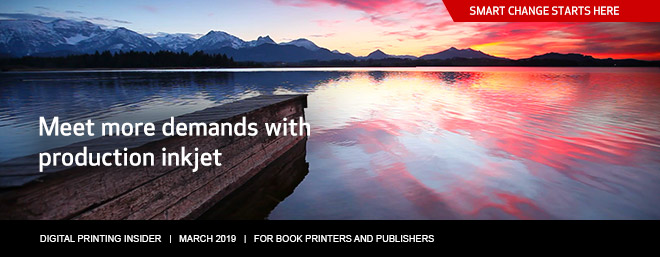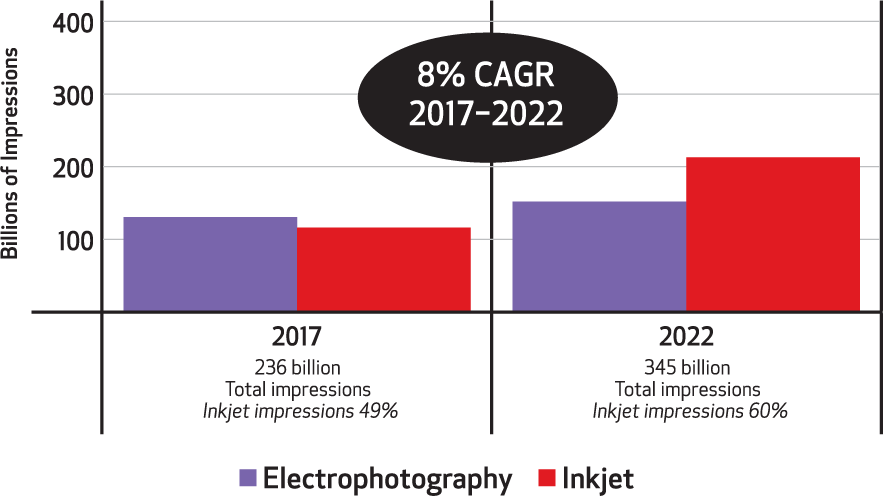Inkjet Applications Shake Up the Publications Market
According to a Pew Research survey conducted in January 2018, printed books continue to be more popular than e-books. The results of this study confirm data from a similar study in 2016 that indicated that printed books held their ground among consumers despite the emergence of e-books and audiobooks.
Digital Print Volume Continues to Grow
Sources: U.S. Print on Demand Market Forecast: 2017–2022, InfoTrends, 2018.
At the same time, however, the readership of printed newspapers, magazines, and even greeting cards is declining. The consequence of the trendlines across the U.S. publishing market is that there are still opportunities for owners of digital equipment because of the trend toward shorter runs for a wider variety of publication types. According to the most recent forecast from Keypoint Intelligence—InfoTrends, publishers of greeting cards, newspapers, books, and periodicals are expected to decline at an overall CAGR of -1.1 percent. Standing on their own, though, books represent a bright spot and are rising slightly at a CAGR of 0.5 percent.
To be an enabler of short-run book, magazine, and even newspaper solutions, the trend is to adopt high-speed inkjet presses. InfoTrends’ data shows continued growth in digital production color, with volumes expected to reach 345 billion by 2022. Inkjet is expected to represent 60 percent of that total, and this share might increase as more books, periodicals, and newspapers move to inkjet production on a worldwide basis. A number of applications once thought too expensive for digital production are now possible thanks to innovations in printhead and ink technologies, cost-effective options for migrating offset jobs to digital color, the drive for shorter runs to eliminate warehousing and optimize supply chains, and a drive for more customized communications.
The advantage for printers with high-speed inkjet equipment is that they can print one book just as easily as one hundred books…
Book applications now include more than educational books, trade books, and the wide range of available children’s books, business books, and display books. In today’s industry, anyone can be an author: educators can create their own books and have them printed at a reasonable cost. Several websites now enable families to trace their genealogy, often giving the opportunity to these individuals to create a printed edition of their findings. In addition, the number of short-run book producers continues to increase, and many of these offer easy-to-use websites that enable people to upload text into a prebuilt template that meets the printer’s guidelines. The advantage for printers with high-speed inkjet equipment is that they can print one book just as easily as one hundred books, and they can create optimized workflows to keep books printing and shipping.
Marketing catalogs, directories, “magalogs” (catalogs with article content), and short-run magazines and newspapers are also receiving some of these same techniques. Some printing companies have developed magazine and newspaper products designed for sports teams, event organizers, and local businesses in the food and beverage industry that can benefit from the cost-effectiveness of inkjet production printing. Recent research from InfoTrends (including the 2018 study entitled High-Speed Inkjet Printing in Commercial Print Markets) captured perspectives from current high-speed inkjet customers in key North American market segments. In addition, the research reached out to the next wave of prospective customers to identify their expectations. According to the inkjet users profiled in the research, here are the top reasons why inkjet fits for these publication applications:
- On-demand: As the publishing market continues to transform, the need for on-demand book print production is satisfied by high-speed inkjet presses. From one to many, books and magazines are expected to be printed on-demand using 100 percent inkjet printing. Short-run, localized content, special interest, and custom publishing are also opportunities for on-demand print production.
- Increased color: Inkjet technology gives publishers a cost-effective production choice for more color images, graphics, messages, and maps in applications such as books and magazines.
- Reduced production time and complexity: With inkjet printing, books have a shorter production cycle from order to shipment. They can even print near delivery and shipping centers to further reduce time and costs.
Printing books with inkjet technology also makes it easier to create more personalized publishing products. Regionalized magazines, localized catalogs, and personalized books can easily integrate into a printer’s product offerings with just a small amount of work. As the number of available substrates grows, no option is out of reach. The opportunities are endless?—?ranging from glossy, image-rich travel books to heavyweight children’s books. The core value of production inkjet technology is that it accommodates print applications that are difficult or impossible to produce with other technologies: examples include affordable, high-value personalization; shorter runs; localization; and versioning. High-speed inkjet systems represent a cost-effective alternative to traditional printing methods without sacrificing print quality. High-speed inkjet is delivering value to individuals and publishers as well as book printers of all sizes. It offers affordable digital color and associated improvements in operational costs, production efficiencies, and time-to-market. Organizations that have not yet explored the inkjet opportunity need to act now if they hope to enjoy all its benefits!
Interested in learning more? Check out InfoTrends’ written report or white paper entitled “Inkjet Applications Matter! Opportunities & Trends in Production Inkjet” to see the breakdown of inkjet suitability as well as more data about the inkjet market today.
WATCH THE VIDEO


